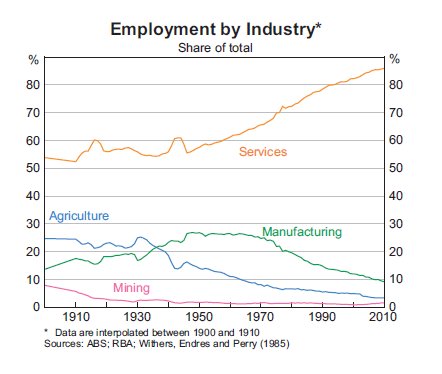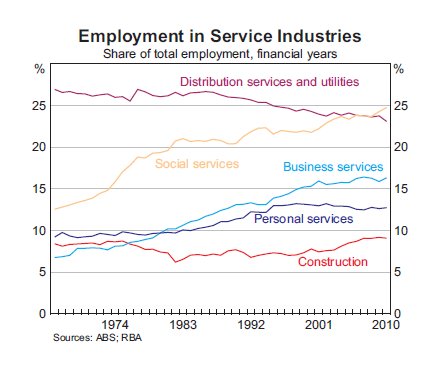The Reserve Bank’s Bulletin this month includes an interesting little paper drawing an outline of the evolution of the structure of production and employment in Australia over the last few decades. [PDF] Staff economists Ellis Connolly and Christine Lewis provide no surprises – just the clarity of a long view with basic stats. (All graphs below are from the paper.)


Just about everybody works in services these days – more than 85 per cent of the employed workforce. That share has risen fairly steadily since the end of World War II, from just over 55 per cent. In the post-war period the growth of the service sector picked up the slack from the declining rate of growth in agriculture; since the late 1960s it has taken over from manufacturing too. In absolute terms, this is a story of service sector expansion rather than decline elsewhere: net employment growth since the war has been almost all about services. Mining has remained steady at around 1 per cent of employment.
When it comes to output shares rather than employment, the picture looks different. Manufacturing and agriculture shares in nominal value added are about the same as their shares of employment. But mining’s share is much bigger, at 7 per cent over the past decade, while services’ share is lower at 78 per cent. Mining is extremely capital intensive, and hence accounts for a much bigger share of value added and investment than its share in employment would suggest, while services tend to be more labour intensive.

When a sectoral category makes up around four-fifths of the economy, it loses much of its usefulness as a category. Connolly and Lewis break services down into five sub-sectors, and the data begin to get more interesting. The distribution and utilities sector – i.e., services related to moving and selling goods, energy and communications – has declined in its employment share since the 1960s. (It would be interesting to see a further breakdown of a category that includes everything from wastewater to supermarkets and internet service providers.) The employment share of social services enjoyed a great leap in the 1970s – and especially the Whitlam years – from around 13 per cent to 20 per cent, and climbed more slowly over the next three decades to reach 25 per cent, to become the largest service sector today. This includes education and health care, public and private, as well as public administration, police and so on.
Business services (including finance, insurance and real estate) have grown more steadily, but especially rapidly in the 1980s and 1990s before stabilising at around 17 per cent of employment over the 2000s. Personal services – restaurants, hotels, cinemas, etc. – had a modest burst of expansion in employment share in the 1980s and early 1990s, taking them from a steady 10 per cent to a steady 12-13 per cent since. Construction’s share has remained between 6 and 9 per cent since the 1970s, though responsible for much of the growth in the share of services as a whole over the 2000s.

Although these shifts are long-run trends, they have run faster at some times than others. The most interesting thing Connolly and Lewis do with this data is to generate ‘structural change indices’ to show the waves of change. These indices measure the average movement in industry and state shares of nominal and real output, employment and investment, to give a simple indicator of structural change over the previous five years. Such a measure is only as meaningful of the categories into which the industry structure is divided – it clearly doesn’t capture movements within the categories. The figure shows two major waves of structural change since the 1960s – one during the 1970s, and one in the late 1980s and early 1990s. (Note that the indices are backward-looking in that each year’s figures compare the average shares of the previous five years with the average shares of the five years before that.)
In terms of real output and employment, the last decade has apparently been more structurally stable than the previous three decades, though not as stable as the 1960s. Things look different in nominal terms, largely because of the effect of booming commodity prices on the value of mining output. Connolly and Lewis expect the commodities price boom to have a delayed impact on the structure real output through the great increase in mining investment over the last half of the 2000s.
The structural change index for employment shows only one wave of accelerated change, rather than the two apparent with output, peaking at the turn of the 1980s, though never returning to the low level of the early 1960s. The 1970s were, of course, the decade that ended full employment. Connolly and Lewis make no connections between the structural shifts they chart and macroeconomic developments, but there would certainly be connections to draw. The reconfiguration of the last quarter of the 20th century was far from painless: manufacturing job growth collapsed long before services growth replaced them, and even in the 2000s unemployment remained well above that of the postwar period.
Connolly and Lewis include ‘economic reform’ among the factors behind the structural changes – in particular, deregulation of service industries and reduction of trade protection. It would be wrong to overemphasise the impact of policy, however – it probably had more impact on the timing of the ‘waves’ than on the long-run processes themselves. The growth of low labour cost manufacturing in East Asia inevitably undercut the profitability of many kinds of manufacturing here, while the proportion of incomes spent on consumer services has long shown a tendency to rise with those incomes.

Although mining accounts directly for a small proportion of output and a tiny proportion of employment in Australia, it is now responsible for more than half the value of exports. The conceptual framework used by Connolly and Lewis has its limitations in understanding the meaning of mining. First, as they note themselves, the sectoral break-down they use misses the cross-sectoral linkages through which mining activity has its multiplied effects: through services – especially construction – and manufacturing oriented towards the mining industry. The statistics on the inter-state shifts in population and output towards Western Australia and Queensland capture these effects of the mining boom better.
Second, to talk of ‘the structure of the Australian economy’ may give a misleading impression of the coherence of the economic system at a national level. To what extent does it make sense to think of mining exports as ‘national’ exports, when they are undertaken by multinationals funded primarily by international capital, employing relatively few people here? In the days of a fixed exchange rate, with foreign exchange centralised in the hands of the Reserve Bank, it was more natural to think of exports earning the currency needed to pay for imports. Now, there is no centralised nexus of international trade. This is not to say that mining is an enclave completely isolated from the mainly urban economy of the Southeast, but that the links are complex. Perhaps the most direct effect of the mining boom on the living standards of Sydneysiders and Melburnians comes through its effect on the exchange rate, cheapening foreign goods and services. The tax take from mining is another – and still a relatively undeveloped resource.






